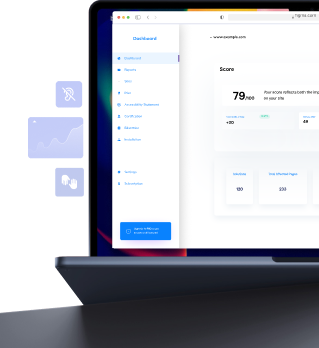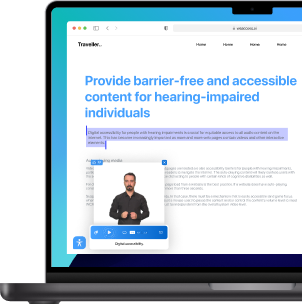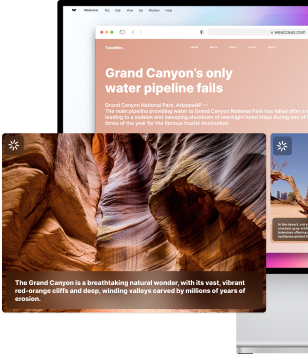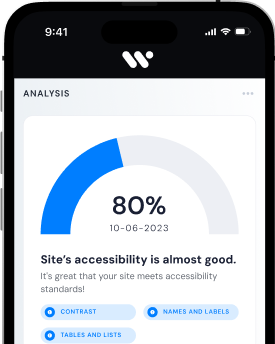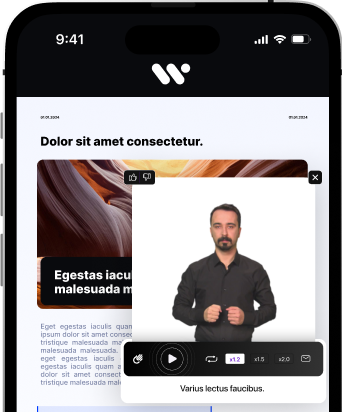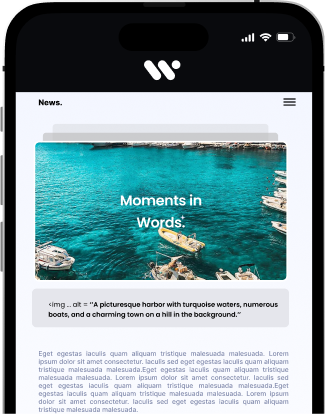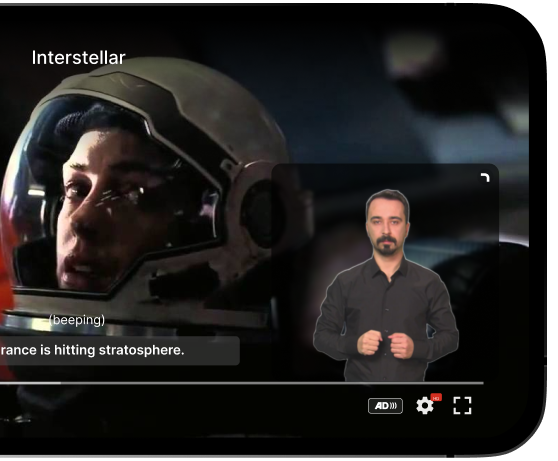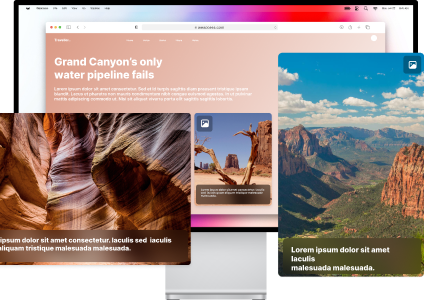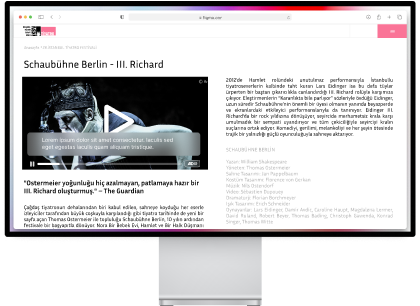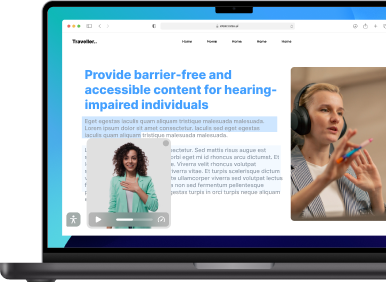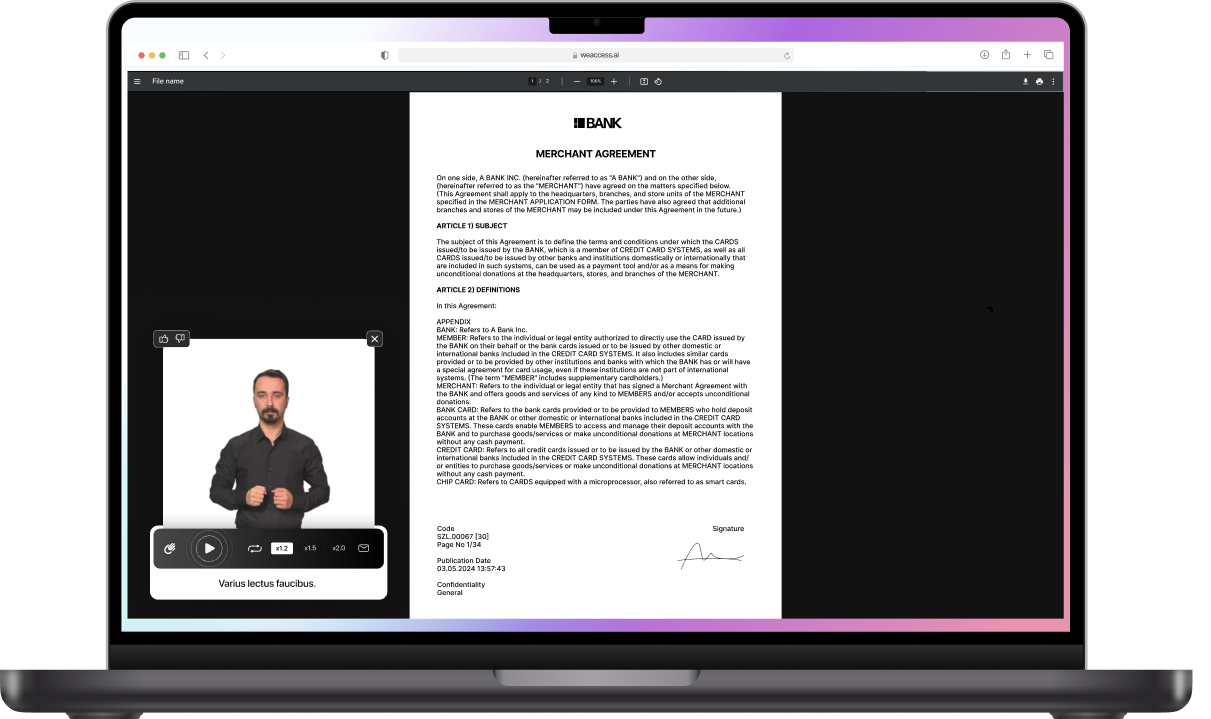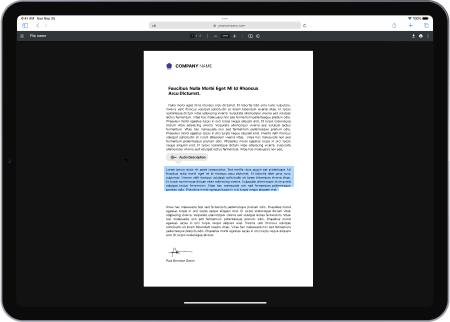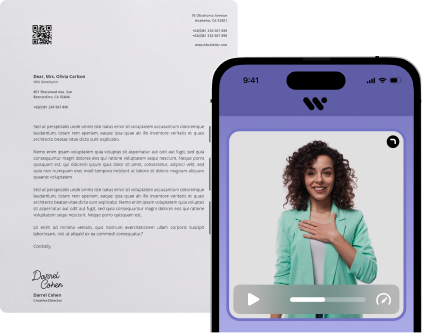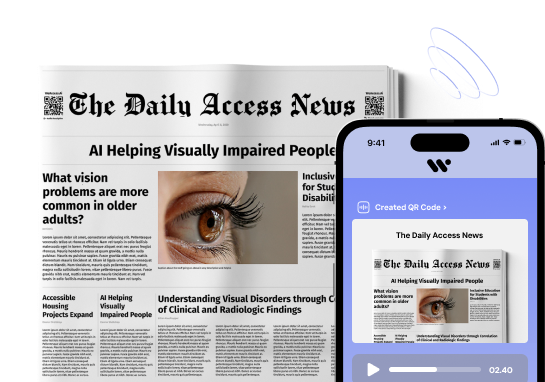5 Common Web Accessibility Errors and Solutions
Today, businesses are unable to offer a seamless experience to their disabled customers due to inadequate accessibility efforts. The main reasons for these inadequacies in accessibility include not consulting with those in the know, not listening to the views of disabled people and not being sustainable.
In addition, the fact that institutions hardly care about this issue also causes widespread accessibility problems. In our article, we will talk about 5 accessibility problems commonly encountered by disabled users on websites and their causes.
Introduction
Before we talk in detail about 5 common accessibility mistakes and their solutions, it's worth briefly recalling a few things. This will give you an idea of what accessibility is and give you a better idea of what accessibility issues you might face in the future. If you would like to learn more about the sub-topics I am about to briefly discuss, you can check out our past blog posts on WeAccess.Ai.
What is Web Accessibility?
Web accessibility is a term that describes the appropriate organization of web content for individuals with visual, hearing or other disabilities. When a website provides a screen reader or high contrast for the visually impaired and an easy-to-understand or sign language supported user experience for the hearing impaired, it is possible to say that the website offers an accessible experience
Why Web Accessibility Matters ?
Like every individual, visually impaired people have the right to access the information they are looking for quickly. Today, the internet is one of the most important resources for accessing information, and people with disabilities, whether visually impaired or hearing impaired, have many opportunities to do their daily work and research for their homework thanks to the accessibility tools developed for them. However, these tools alone are not enough for them to access digital content; developers or owners of websites, desktop or mobile applications should also design their platforms to be accessible in accordance with these tools.
The way for people with disabilities to access the content they want in a comfortable way is through inclusion-based web accessibility studies. Web accessibility is extremely important for the protection of individuals' right to access information.
Impact of Web Accessibility Failures on User Experience
Web accessibility issues have many negative implications for the web browsing experience of people with disabilities. The negative experience that individuals may encounter varies according to the type and degree of disability of the person concerned and the type and degree of the problem or problems experienced on the relevant website. Many websites today have some basic level of accessibility features, but often the platform owners are not aware of this. Therefore, just because a website is partially accessible today does not mean that it will be accessible tomorrow.
- In general, accessibility issues on a website can lead to many negative user experiences, such as The lack of high contrast options for individuals with low vision prevents them from comfortably navigating the website in the desired contrast mode.
- For people with no vision at all, the lack of shortcuts on websites, including jumping to the main area, can cause them to waste time trying to find the information they are looking for.
- Websites for visually impaired individuals whose design process is not properly designed make it difficult to navigate with screen reader software.
Part 1: Accessibility Error - Insufficient Color Contrast
The Importance of Color Contrast in Web Content
Individuals with low vision can make various choices such as not using screen reader software or using screen reader software and other assistive tools together, depending on their degree of disability. In 2 cases, there are different ways for individuals to consume web content according to their needs and preferences. Color contrast in web content is one of them.
You can briefly think of color contrast as a theme change on the website. For example, when you activate the dark mode option in Android and iOS operating systems, you will see that the background of the Settings section of your phone is black and the text is white. This is a high contrast option, but when it comes to the needs of a low vision user, a much more flexible, customizable solution is needed that can be used in every part of the operating system. This is where high contrast options for people with low vision come in.
Standard web content with black text on a white background can cause eye pain for people with low vision who read it with their eyes. There are also different diseases that cause the eyes to be sensitive to certain colors. For all these users, it is important to offer high contrast options on websites.
When the user chooses the high contrast theme that suits their needs, they will be able to navigate the relevant website much more comfortably. He will be able to read the articles very comfortably, navigate through the page contents and will not feel the slightest discomfort while doing all this.
What Are the Consequences of Missing High Contrast Options on a Website?
First of all, not having high color contrast themes on your website is a major accessibility flaw. Nowadays, many low vision individuals try to overcome this deficiency that we see on most of their websites by using the color contrast/high contrast plugins included in their web browsers, but these plugins are sometimes not very efficient.
For example, some websites do not support these plugins and open in standard view. Other websites may not display properly due to these plugins and this completely prevents a person with low vision from taking advantage of the website. In fact, if these websites natively offered high contrast mode options, a low vision user would not have these problems and would be able to enjoy their basic right to information.
As you can see, the lack of high contrast options will often result in negative experiences for a low vision blind person. For this reason, website owners should work on this issue as soon as possible and include various color contrast options on their websites.
Factors to Consider in Color Selection
If you look at mobile apps or websites with high contrast options, you will notice that there is often more than one option available to users. The main reason for this is that different eye diseases cause different color sensitivities. For example, the eyes of a visually impaired visitor may be very sensitive to the color white, meaning that text or web pages in this color may irritate their eyes. Therefore, it is very important to offer multiple theme alternatives for high contrast.
A website visitor with low vision may have different needs based on the background. Therefore, when working on high contrast themes for websites, it will be useful to consider different user requirements.
Color Contrast Tools and Test Methods
You can browse the plugin stores of CMS software (content management systems) for web contrast tools, or you can work with a web designer if you are using a custom content management software. But with the solutions we offer at WeAccess.Ai, it's easier than ever to enable these features on your platform. Read on for details.
As with any process, you need to test high-contrast themes after activating them on your website. This allows you to react quickly to any potential problems. You should make sure that everything on your website (e.g. submenus, pages, content pages, subpages) displays correctly when any high contrast theme is activated. If you find a problem at this stage, you should fix it before making the feature publicly available.
Of course, the people with low vision who visit your website will tell you how positive high contrast themes are for the browsing experience.
Therefore, you should reach out to people with low vision for end-user testing and get their feedback. You can improve this feature based on the feedback you receive.
Section 2: Accessibility Error - Missing Alternative Texts
The Role and Importance of Alternative Texts in Visuals
Today, we are exposed to more and more visual content in the content we consume. Visuals are crucial to make a piece of content stand out, and that's why businesses around the world, regardless of the industry they operate in, make sure to use appropriate visuals when describing their services, showcasing their products or creating blog content. Visuals are also an important tool for enriching a content or making it easier to understand.
So what happens when visually impaired individuals using screen reader software encounter an image while browsing the web? If the relevant images have alternative text, the screen reader software reads the description of the image for the blind individual. However, if there is no alternative text attached to the image, a visually impaired user can only use the screen reader to understand that the item they are on is an image, and if there is a caption written for the image, the screen reader will voice it.
In short, in order for visually impaired people to learn what is in the images on a website, it is of great importance to create alternative texts for those images. If your goal is to provide an inclusive experience for everyone on your website, don't forget to add alt texts for disabled users to the images in your content.
How to Create the Right Alternative Texts for Images
CMS software (WordPress, OpenCard, Jaonna, etc.) allows you to manually add alt text to images. If your website runs on the infrastructure of this type of content management system software, you can manually create alt texts for a new image you will upload or for images that are already on your website.
The alt texts you create should clearly state what is included in the image. However, depending on the type of image, the level of detail you need to mention may vary. For example, for product images on an e-commerce site, you do not need to describe the product, it is important that the user knows what the product is. However, on a page or pages with detailed product features and promotion, the images of the product should be explained in detail.
What is the Difference Between Decorative Images and Informational Images?
Decorative images do not contain details about the information a visitor needs, their purpose is to color a website or website content. For this reason, it is sufficient to know the object in the image, and for this, the image title is often enough. Due to SEO compatibility, the ability to easily find the image when needed, and many other issues, content creators need to add a title to the images they upload to the website they are already working on.
The situation is different for images that convey information to the visitor. These images include almost all images other than decorative images and can be used for many purposes, from illustrating something to explaining something in text. For an inclusive experience, it is imperative to always add alternative text to these images.
Let's say a visually impaired user searches for a tablet computer model on brand X's website. In order to get detailed information about a model that interests him during his research, this user clicks on the link of the relevant product and is greeted by a page with details. Here, the tablet's multi-window experience is emphasized and, just below the relevant text, there is a picture showing this in action. If this picture shows in detail how the tablet computer is positioned and what it is showing at that moment, the consumer will understand the experience offered by the product more clearly. But otherwise, a visually impaired consumer will not be able to understand it.
Automatic and Manual Alternative Text Insertion Methods
To manually add alt text to images, you can use the features of your content management software. When it comes to doing this automatically, we have a great service for you, WePhoto.
At WeAccess.Ai, we have developed WePhoto, an AI-based service that can automatically create alt text for images on your website. Read on to learn more about WePhoto.
Section 3: Accessibility Error - Page Layout Problems
How Do Layout and Structural Issues Affect Accessibility?
Regardless of whether a website is disabled or unblocked, the way for people to quickly access what they are looking for is always through a well-constructed design. A website with a poor page layout and structural problems will not attract much attention from users. When it comes to accessibility, the negative effects of such problems unfortunately increase.
One way or another, an ordinary user can do their job on a poorly designed website if they have to, even if it is difficult. But for a visually impaired user, this may not be possible.
Poor page layout makes it difficult to navigate with a screen reader. For example, if the appropriate items are not collected in a sub-menu on a website, or if there are problems with the links to the top and bottom sections, these are problems related to page layout.
Again, filling the website with unnecessary components, having more sliders and menu areas than it should be are also among the problems related to page layout. Problems with layout can also be in the content, the most important point here is to properly analyze what could be a problem. Structural problems on the website are mostly caused by incorrectly constructed elements. For example, not using the correct labels on links and buttons are among the structural problems. So how does this affect accessibility?
First of all, someone using a screen reader cannot easily navigate the website or access the content they are looking for due to problems with the layout. Excessive disorganization also causes confusion.
On the other hand, too many slider areas also negatively affect the browsing experience with a screen reader. For example, a visually impaired user who visits a website to read the news may have problems accessing current news due to excessive sliders.
Structural and layout issues can also negatively affect the keyboard navigation experience. For example, not labeling buttons and links as "button or link" makes it difficult for people using navigation shortcuts to navigate between these items with their keyboard. Structural and layout issues on a website can lead to many more negative experiences than the ones listed here, so it is important that they are properly identified and resolved.
The Importance of Using HTML Tags Correctly for Accessibility
Html tags (headings, text type tags, etc.) are critical for accessibility at certain points. First of all, the correct construction of headings allows a visually impaired visitor to navigate more easily between main and subheadings on a website. It is important to use heading tags only when necessary, and H tags should not be used for standard paragraphs or topics that do not need to be separated by a heading.
On the other hand, the use of options that affect font type, such as bold and italics, does not have a negative impact on accessibility. The correct use of list items, links and much more in a blog post or a listing page is crucial for a seamless experience with the screen reader.
Keyboard Accessibility and Navigation Arrangements
The ability of people using screen reader software to navigate a website more easily with keyboard shortcuts is related to the correct organization of the website content. The correct title layout of a website or the content on the website, the correct labeling of buttons or links, the presence of various shortcuts to quickly access certain sections of the website, the correct creation of footer, header and other sections will positively affect the keyboard navigation experience of users. It is also important that a website is structurally designed to allow keyboard navigation.
The Necessity of Responsive Design for Mobile Devicesn
Today, the majority of internet traffic is now coming through mobile devices. Research has revealed that more than half of the people who use the internet mostly use their smartphones to access the web. This has increased the importance of mobile-friendly designs for websites.
A mobile-friendly website design is also very important for accessibility. If a user using a screen reader is greeted with a non-mobile-friendly web page while searching on their smartphone, this can cause a problematic browsing experience for that user. The cursor structure on mobile screen readers is different from desktop screen readers.
Therefore, when a user wants to click on the link they are looking for on the website, the screen reader cursor can be focused in a very different place and can be confusing. Also, people who use magnification gestures in addition to the screen reader have problems reading the content on the relevant website with their eyes from their smartphones due to the desktop design.
In addition, screen readers may experience various instability problems on a website that is not mobile-friendly. In order to avoid all these problems, mobile-friendly website designs are a must.
Section 4: Accessibility Error - Accessibility of Video and Audio Media
Subtitles and Accessibility
Many media player applications offer support for closed captioning (CC) for movies and TV series. Subtitles activated through the media player can be spoken by screen readers.
Similarly, subtitles for content on Netflix or Amazon Prime can also be read with a screen reader. This makes it much easier to consume foreign-language content. However, subtitles added directly to a video through video editing software cannot be read directly with screen readers. Therefore, it is important for content creators to take advantage of the options offered by platforms such as YouTube.
Inadequacy of Audio Descriptive Content
Visually impaired individuals may prefer to watch movies or TV series with audio description if appropriate. Audio description refers to the explanation of the visual elements in a movie or series scene to the audience in the background. However, the number of content with audio description is not sufficient considering today's conditions.
Although platforms such as Netflix and Amazon Prime offer audio description in the language of a region for local original content, it is not possible to access audio description in every language when it comes to other content on the platform.
Moreover, audio description is a feature that may be needed not only for TV series or movies, but even for a YouTube video. For this reason, audio description applications should become widespread and platforms such as YouTube should include audio description options in their applications.
So, is there a technology that makes it easier for us to benefit from audio description today? If you ask, the answer is yes. As WeAccess.Ai, we will talk about our artificial intelligence-based accessibility solutions at the end of our article.
Limitations of Automatic Voice Recognition Technologies
Video content networks such as YouTube are working with automatic voice recognition technologies that allow videos to be automatically captioned. However, these technologies have limitations and their results can sometimes be inefficient.
For example, these tools are notoriously inefficient when it comes to punctuation. For this reason, when you examine the subtitle and transcription features on YouTube, you will see that most sentences do not contain punctuation marks such as periods and commas.
In addition, depending on the speaking speed, dialect or distance of the person in front of the microphone, there may be problems in the perception of words. This can cause you to see meaningless sentences or phrases in the subtitle or transcript section of the video. The reason for all these situations is that voice recognition technologies have not yet reached a level that meets the conditions of daily life. For this reason, it would be beneficial for content producers to do the subtitling and transcription work for the video themselves, if possible.
Accessibility Friendly Features of Media Players
Media player applications and video content platform websites have some features that make life easier for visually and hearing impaired groups. First and foremost, the media players used in the computer environment today have many keyboard shortcuts. When we look at mobile platforms, we see that there are shortcuts such as forward/rewind, video pause, which can be used with the control shortcuts of screen reader software.
Subtitle options can also be used in video players for hearing impaired individuals.
When it comes to channels like YouTube, shortcuts that can be used with keyboard key combinations meet us on the computer side. When it comes to mobile devices, we can say that all player shortcut buttons are accessible with screen readers.
However, not all app developers approach the issue in the same way as Google or Microsoft, which leads us to see various accessibility issues in other third-party software.
Section 5: Accessibility Error - Lack of Keyboard Accessibility
Why Keyboard Accessibility is Important for the Visually Impaired ?
Keyboard controls allow a visually impaired person to use a computer quickly, just like a sighted person. With a screen reader, a visually impaired user can use various keyboard keys or key combinations to navigate between headings, list items, paragraphs, links, images, and more on a website, search a website, and more. It is very important for a website to be compatible with keyboard shortcuts because it improves the computing experience for the visually impaired.
How Do Mouse-Based Designs Affect the Navigation Experience of Visually Impaired People?
Many websites today have various sub-menus that are activated on mouse hover, but in many cases are difficult to access with screen readers. While it is very easy to navigate through these menus with the mouse, it is almost impossible with keyboard controls if not rendered correctly. Likewise, text boxes based on mouse controls and much more, if not rendered in an accessible way, the visually impaired user cannot reach them with standard navigation controls. There are ways to make these submenus accessible.
How to Provide a Keyboard-Driven Navigation Experience?
In order to provide a keyboard-oriented navigation experience on a website, the content structure of the website needs to be designed appropriately. For this purpose, title tags can be used correctly, lists, links and other elements can be added correctly.
Another important point is to provide technical improvements. For this purpose, menus and areas such as header and footer on websites should be designed in such a way that they can be accessed with the keyboard. For example, for a menu that is interacted with the mouse, various structural changes can be made, such as pressing the "Enter" key to access its content when hovering over the menu while navigating with the keyboard. In this way, the mouse navigation experience is preserved and screen reader users can navigate the website comfortably. What are the Tools for Testing Keyboard Accessibility?
As WeAccess.Ai, we have developed 2 tools, WeAnalyse, which allows you to test not only keyboard accessibility on your website, but everything on the accessibility side, and WeTool, which can solve all these problems. These 2 services work with artificial intelligence and guide you to solve accessibility problems.
Apart from that, the best way to test keyboard accessibility is to reach out to groups of visually impaired end users and get their feedback. This is much better for adapting to real-life conditions.
The Overall Impact of Web Accessibility Errors and the Importance of Raising Awareness
Most fundamentally, problems related to web accessibility undermine the right of people with disabilities to access information. Access to information is everyone's right and all institutions and organizations that care about this right should fulfill their responsibilities for digital accessibility.
Companies that have successfully completed their digital accessibility processes should contribute to raising awareness by communicating this to both the public and their competitors in the right way. On the other hand, media members, journalists and digital content producers should also make efforts to raise this awareness.
from many of your competitors who do not. It also opens the door to a truly inclusive experience for everyone.
Which Applications Can Be Used to Improve Web Accessibility?
As WeAccess.Ai, we have developed various tools to identify accessibility problems on your websites, solve these problems and open the doors to a more accessible experience. Thanks to these tools, companies will be able to complete accessibility practices in less time.
- WeAnalyse: WeAnalyse scans all pages and content on your website with artificial intelligence to help identify existing accessibility issues. As a result of the artificial intelligence review, a comprehensive report is presented to you. First page analysis with WeAnalyse is completely free. Click to try (link will be provided)
- WeTool: WeTool is a tool that solves accessibility issues on your website with the support of artificial intelligence. By integrating WeTool into your website, you can have existing accessibility issues resolved automatically. WeTool regularly scans your website and when it detects new issues, it solves them for you. If you suspect a bug or technical problem on your website, you can configure WeTool in any way you like.Click here to view the WeTool page (link provided)
- WePhoto: Our WePhoto tool allows you to create alternative texts for images with the help of artificial intelligence. You can edit these AI-generated alternative texts or use them as they are.Click here to view the WePhoto page.(link will be provided)
Give Importance to Website Accessibility, Increase the Number of Users!
By paying attention to accessibility on your website, you will not only reach visually impaired users. Users with disabilities will recommend you to others and sensitive people will tend to visit your website, recognizing the importance you attach to the issue. Also, by publicizing this issue in the right way, you can reach more sensitive customers. In this way, there will be many user groups who choose you.
Together with you, we have examined 5 common problems in web accessibility and looked closely at how they can be solved. We also got to know WeAccess.Ai's solutions to guide you. As WeAccess.Ai, we will continue to produce blog content that will increase your awareness and open new horizons for you.
You may be interested : Digital Accessibility and Customer Satisfaction

